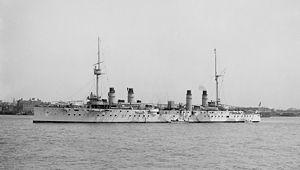
| |
| History | |
|---|---|
| Name | Dupleix |
| Namesake | Joseph François Dupleix |
| Ordered | 18 December 1897 |
| Builder | Arsenal de Rochefort |
| Cost | FF16,308,850 |
| Laid down | 18 January 1899 |
| Launched | 28 April 1900 |
| Commissioned | 15 September 1903 |
| Decommissioned | 1 May 1919 |
| Stricken | 27 September 1919 |
| Fate | Sold for scrap, 1922 |
| General characteristics | |
| Class and type | Dupleix-class armored cruiser |
| Displacement | 7,700 t (7,578 long tons) |
| Length | 132.1 m (433 ft 5 in) (o/a) |
| Beam | 17.8 m (58 ft 5 in) |
| Draft | 7.46 m (24 ft 6 in) |
| Installed power |
|
| Propulsion | 3 shafts; 3 triple-expansion steam engines |
| Speed | 20.9 knots (38.7 km/h; 24.1 mph) |
| Range | 6,450 nmi (11,950 km; 7,420 mi) at 10 knots (19 km/h; 12 mph) |
| Complement |
|
| Armament |
|
| Armor |
|
The French cruiser Dupleix was the lead ship of her class of three armored cruisers built for the French Navy in the first decade of the 20th century. Designed for overseas service and armed with eight 164.7-millimeter (6.5 in) guns, the ships were smaller and less powerfully armed than their predecessors. Completed in 1903, Dupleix was initially assigned to the Atlantic Division (Division de l'Atlantique) as its flagship. The ship spent 1906 to 1909 in reserve before she was sent to the Far East in 1910, again serving as a flagship.
When World War I began in August 1914, the cruiser was still in the Far East. Before she was transferred to the Eastern Mediterranean in May 1915, Dupleix spent most of her time on escort duty in the Indian Ocean and Red Sea. Over the next year, she was tasked to blockade the Aegean coast of Ottoman Turkey. To help protect Allied shipping from German commerce raiders, the ship was transferred to French West Africa in mid-1916 and remained there until October 1917 when she returned to France to be placed in reserve. Dupleix was decommissioned in 1919 and was sold for scrap in 1922.